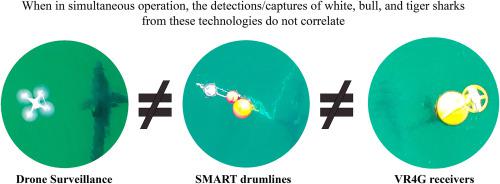当前位置:
X-MOL 学术
›
Ocean Coast Manage.
›
论文详情
Our official English website, www.x-mol.net, welcomes your
feedback! (Note: you will need to create a separate account there.)
Comparing distributions of white, bull, and tiger sharks near and away from the surf break using three tech-based methods
Ocean & Coastal Management ( IF 4.8 ) Pub Date : 2020-12-01 , DOI: 10.1016/j.ocecoaman.2020.105366 Andrew P. Colefax , Paul A. Butcher , Daniel E. Pagendam , Brendan P. Kelaher
Ocean & Coastal Management ( IF 4.8 ) Pub Date : 2020-12-01 , DOI: 10.1016/j.ocecoaman.2020.105366 Andrew P. Colefax , Paul A. Butcher , Daniel E. Pagendam , Brendan P. Kelaher

|
Abstract Unprovoked shark bites are one of the most recognised human-wildlife conflicts in the marine environment. Historically, management of this threat to public safety largely involved the implementation of lethal strategies. However, there is increasing environmental necessity and social pressure to adopt alternative strategies that minimise harm to sharks and other marine life. While different approaches have been developed that aim to reduce the risk of shark interactions with people, it is difficult to quantify their efficacy due to the rarity of shark bites and a lack of understanding of localised distributions of white (Carcharodon carcharias), bull (Carcharhinus leucas), and tiger (Galeocerdo cuvier) sharks, particularly close to surf breaks. Here, we used a rare opportunity to compare observations of these three ‘target’ shark species nearshore from drone-based surveillance to those caught on SMART (Shark-Management-Alert-in-Real-Time) drumlines and detected from VR4G acoustic receivers, with the latter two both located approximately 500 m offshore. Across 243 operational days, where all three methods were in use off three separate beaches on the east coast of Australia, we found no evidence for nearshore drone-based observations of target shark species to correlate with catches from SMART drumlines or detections from the VR4G acoustic receivers. The absence of correlation was still evident when 2-day, and 3-day moving averages of catches from SMART drumlines and detections from acoustic receivers were considered. While drone-based surveillance can incur sightability errors, it was evident that SMART drumlines do not prevent sharks from entering near the surf zone, and this does not coincide with the portion of sharks detected by the VR4G acoustic receivers. We contend that there is a need for a greater understanding of behavioural processes of large predatory sharks that may pose a threat to ocean users, particularly when considering non-destructive approaches to shark mitigation.
中文翻译:

使用三种基于技术的方法比较靠近和远离冲浪点的白鲨、公牛鲨和虎鲨的分布
摘要 无端鲨鱼咬伤是海洋环境中最常见的人类与野生动物冲突之一。从历史上看,对这种对公共安全的威胁的管理主要涉及实施致命策略。然而,越来越多的环境需要和社会压力需要采用替代策略来最大限度地减少对鲨鱼和其他海洋生物的伤害。虽然已经开发了不同的方法来降低鲨鱼与人互动的风险,但由于鲨鱼咬伤的罕见性以及对白色(Carcharodon carcharias)、公牛(Carcharhinus)的局部分布缺乏了解,很难量化其功效。 leucas)和虎鲨(Galeocerdo cuvier),特别是靠近冲浪点。这里,我们利用难得的机会将近岸这三种“目标”鲨鱼物种的观察结果进行比较,这些鲨鱼物种从基于无人机的监视到通过 SMART(Shark-Management-Alert-in-Real-Time)鼓线捕获并从 VR4G 声学接收器中检测到的,以及后两者都位于离岸约 500 m 处。在 243 个运营日中,在澳大利亚东海岸的三个独立海滩上使用了所有三种方法,我们没有发现任何证据表明基于近岸无人机对目标鲨鱼物种的观察与来自 SMART 鼓线的捕获量或来自 VR4G 声学的检测相关联接收器。当考虑来自 SMART 鼓线的捕获量和来自声学接收器的检测的 2 天和 3 天移动平均值时,相关性的缺失仍然很明显。虽然基于无人机的监视可能会导致视线错误,很明显,SMART 鼓线不会阻止鲨鱼进入冲浪区附近,这与 VR4G 声学接收器检测到的鲨鱼部分不一致。我们认为,需要更深入地了解可能对海洋使用者构成威胁的大型掠食性鲨鱼的行为过程,尤其是在考虑采用非破坏性方法来减轻鲨鱼影响时。
更新日期:2020-12-01
中文翻译:

使用三种基于技术的方法比较靠近和远离冲浪点的白鲨、公牛鲨和虎鲨的分布
摘要 无端鲨鱼咬伤是海洋环境中最常见的人类与野生动物冲突之一。从历史上看,对这种对公共安全的威胁的管理主要涉及实施致命策略。然而,越来越多的环境需要和社会压力需要采用替代策略来最大限度地减少对鲨鱼和其他海洋生物的伤害。虽然已经开发了不同的方法来降低鲨鱼与人互动的风险,但由于鲨鱼咬伤的罕见性以及对白色(Carcharodon carcharias)、公牛(Carcharhinus)的局部分布缺乏了解,很难量化其功效。 leucas)和虎鲨(Galeocerdo cuvier),特别是靠近冲浪点。这里,我们利用难得的机会将近岸这三种“目标”鲨鱼物种的观察结果进行比较,这些鲨鱼物种从基于无人机的监视到通过 SMART(Shark-Management-Alert-in-Real-Time)鼓线捕获并从 VR4G 声学接收器中检测到的,以及后两者都位于离岸约 500 m 处。在 243 个运营日中,在澳大利亚东海岸的三个独立海滩上使用了所有三种方法,我们没有发现任何证据表明基于近岸无人机对目标鲨鱼物种的观察与来自 SMART 鼓线的捕获量或来自 VR4G 声学的检测相关联接收器。当考虑来自 SMART 鼓线的捕获量和来自声学接收器的检测的 2 天和 3 天移动平均值时,相关性的缺失仍然很明显。虽然基于无人机的监视可能会导致视线错误,很明显,SMART 鼓线不会阻止鲨鱼进入冲浪区附近,这与 VR4G 声学接收器检测到的鲨鱼部分不一致。我们认为,需要更深入地了解可能对海洋使用者构成威胁的大型掠食性鲨鱼的行为过程,尤其是在考虑采用非破坏性方法来减轻鲨鱼影响时。











































 京公网安备 11010802027423号
京公网安备 11010802027423号